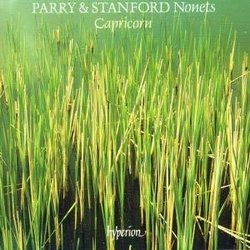| All Artists: Parry, Capricorn Ensemble Title: Nonet in B Flat Members Wishing: 1 Total Copies: 0 Label: Hyperion UK Release Date: 11/15/1993 Genre: Classical Styles: Chamber Music, Forms & Genres, Serenades & Divertimentos Number of Discs: 1 SwapaCD Credits: 1 Other Editions: Faure: Requiem; Cantique de Jean Racine; Messe basse UPC: 034571162911 |
Search - Parry, Capricorn Ensemble :: Nonet in B Flat
CD Details |
CD ReviewsOtherworldly Richard Wells | Seattle, WA USA | 03/13/2001 (5 out of 5 stars) "I am hardly a classical music maven. I listen as others might use recreational drugs - when all else fails I hope a piece of classical music will take me out of myself and let me get a little closer to heaven. An opportunity to bathe in beauty. The reason it doesn't often work is because just as I'm about to transcend the composer changes dynamics and the bath turns into a perfect storm. Not so with this work. Forty minutes of undiluted peace, but with complexities that demand active listening. Vocals and instruments are of such a whole that I found myself listening to strings that unfolded as a voice, and vice versa. The vocal combinations and close harmonies were flawless. There was not a moment that was not gorgeous, and any loss of attention was caused by my own wandering mind rather than any jarring musical effect. These are the sounds I would like to accompany me on the big transition - they would open the gates." The perfect recording Steven Guy | Croydon, South Australia | 03/21/2007 (5 out of 5 stars) "I have heard a number of soprano & countertenor teams sing the Stabat Mater since this recording was made, Kirkby & Bowman (the use of a harpsichord annoyed me in that recording) and Bonney & Scholl (the voices were mismatched, IMHO - Maria Cristina Kiehr would have been a better partner for Scholl, David Daniels a better partner for Bonney) immediately come to mind, but none move me and impress me like this recording. I think that this is one of the finest recordings of 18th century sacred music I've ever heard, it is certainly the most moving recording I've heard. The voices of Michael Chance and Gillian Fisher blend perfectly and both sing with great style and conviction. Something of a "dream-team", to use a colloquialism, in fact. The dissonances are brought out most effectively and poignantly ... and without distracting and unnecessary vibrato. You'll never heard the seconds, sung in the opening movement, with more precision and bite than on this recording! The King's Consort uses a small number of strings, organ and theorbo accompaniment. Robert King's choice of tempi is natural and effective. The recorded sound and the acoustical environment of the recording is perfect, neither is it too dry nor too reverberant. All in all, an ideal recording of this masterpiece from this tragically short lived composer. I own this recording and, although I've heard other recordings, including the one with Andreas Scholl, a favourite singer of mine, I have never felt tempted to buy another recording." A voice teacher and early music fan George Peabody | Planet Earth | 03/22/2006 (5 out of 5 stars) "GRAMOPHONE SAYS: 'THIS IS SO GREATLY SUPERIOR TO ALL PREVIOUS RECORDINGS OF PERGOLESI'S DEATHBED STABAT MATER AS TO PUT THE OTHERS COMPLETELY OUT OF THE RUNNING'.
Giovanni Battista Pergolesi achieved only modest success during his short lifetime, but the twenty years following his death(at the age of 26) in 1736,saw an extraordinary change, turning him into one of the most-published composers of the 18th century. An Eighteenth Century French writer described the 'Stabat Mater', completed as the composer lay dying, as the 'masterwork' of Latin music'. Although this is music of great tenderness and sombre beauty, the work also includes chromatic sequences, sighing passages and dramatic dissonance straight out of the operatic style that made Pergolesi famous. The Stabat Mater is a setting of the sequence for the Feast of the Seven Dolours (sorrows) of the Blessed Virgin Mary, and was written during Pergolesi's last few months. Harmonically Pergolesi was ahead of his time; one technique he made use of was the application of chromaticism to create a bitter-sweet tone of expressive sensibility. In addition there is an operatic element such as is contained in the jaunty "Quae morebat" sung by the alto (Michael Chance). The Salve Regina with its A minor setting and supplicatory text,contains many hallmarks of the Stabat Mater; from the expressive sighing of the 'Ad te suspiramus' to the contrasting misic of the strong 'Ad te clamamus' sung by the soprano (Gillian Fisher). "In coelestibus regnis" (sung magnificently by Chance) is an example of the short type of piece that Pergolesi might have found time to write in between his operatic commisions. This is a truly exquisite and exciting recording featuring the WONDERFUL voices of Michael Chance -countertenor and Gillian Fisher-soprano. I have 2 other recordings of this music; neither of them come even close to the perfection of this one.!!!!!! Since I wrote the above review I have purchased two other recordings of this work pairing Chance with a sopranist Jorg Waschinski. Although tempos and interpretations are the same it has an entirely different flavour; not unpleasant, however. The other recording features Chance with a soprano Maya Boog and is performed in German; now THIS is different and a bit hard to get used to, so I'll stand by my above statements that the Chance-Fisher recording is superior. This was recorded in December, 1987, and the accompanying booklet is in French, German and English. However, the text is only translated from the Latin to the English." |

